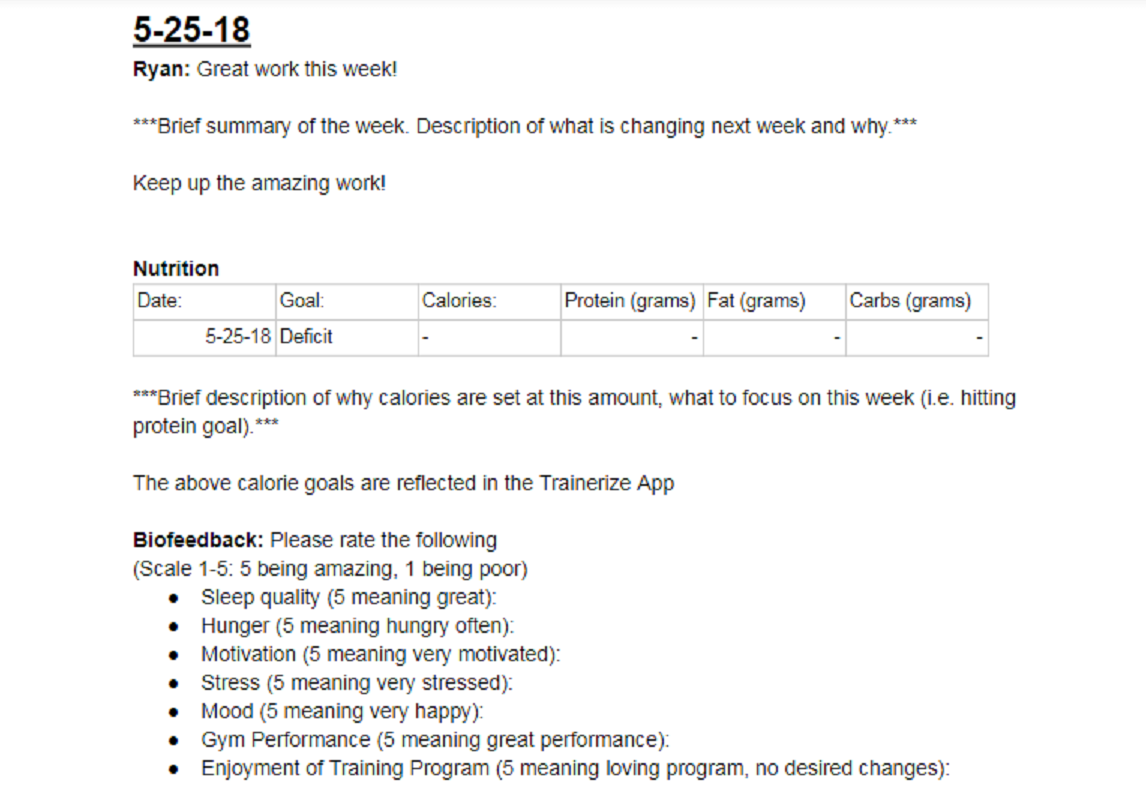26 Jun How Do I Train People Online, Anyway?
It’s almost taboo, the question seldom asked but never lurking far beneath the surface:
How the fuck do I train people online, anyway?
Since the question is too horrible and too basic to ask, the doubters hide behind other questions like:
“Is Trainerize better than MyPThub?”
“How often should I do phone calls with online clients?”
“Is using templates cheating?”

But it’s all a smokescreen that hides the real issue. Many trainers never really get started with online training. They collect endless information and may even pick up a certification or go through a business coaching program along the way.
And yet they still fail to act. The reason is simple.
They can’t sell online training because they don’t really believe in it themselves.
They question the efficacy of training people without standing beside them in the gym.
But the doubters are wrong. You can get excellent results for clients while working fewer hours and making more money than working full-time at a gym. It all comes down to:
- Experience
- Accountability
- Assessment
- Learning How To Scale
- Stepping Into The Ring
Let’s tackle each one, and demolish some myths along the way.
Get Some Experience As A Trainee
Most would-be online trainers have never been through online training themselves. That’s really very strange when you come to think of it. It’s a bit like trying to learn how to become a football coach without ever having played the game.
Jorden Pagel is a big believer in coaches getting online training themselves before offering online coaching to clients. Jorden works with us at Bach Business Coaching, has his own online clients, and also does nutrition coaching for Stronger U.
Jorden says it’s important to “learn how the whole process works from somebody who’s done it for a while.” Jorden thinks it’s “a big step” too many coaches skip.
Why Accountability Is Key
For Patrick Murphy, an online coach in Florida, the big issue in getting started was “I can send anybody a program, but how am I going to make sure they are actually doing the program? How do I know they’re staying committed to what I’m telling them to do?”
Patrick discovered what so many other successful online trainers have: the importance of frequent check-ins. He texted his first clients almost every day and followed up via email once or twice a week.
“It’s a little email that I put together. It was just kind of a ‘Rate how you feel’ type thing. Smiley face, sad face type thing. Just very simple.”
Jeremey Bair also uses a weekly check-in form. Here it is.
General Check-In Questions
Please answer the following to the best of your ability:
Any frustrations this week?
What went well this week?
What didn’t go well this week?
What will you do better next week and how will you do it?
Any there any other movement patterns and/or body parts you would like to put more focus on?
Any events this week you need help working calories around?
What can I do to help you more?
Any other questions/comments/concerns?
Which brings us to destroying the biggest myth of all:
Regular Skype or phone calls are essential to delivering online training.
No, they’re not. Really.
Most of the heavy lifting can be done through a platform like Trainerize, texts, and email check-ins. That’s how the communication, feedback, and coaching happen most of the time.
Just make sure you manage expectations. Don’t offer 24/7 text access unless you are prepared to respond quickly and charge accordingly.
Don’t offer weekly phone calls unless counseling (eg. nutrition habits) is integral to your program.
Deliver what you promise, but beware of “giving too much” by over-delivering and not getting paid for it.
Remember the biggest advantage of an online system is your ability to scale, track, assess, and hold your clients accountable to teach them how to become self-sufficient.
By leveraging the proper software and systems, you can streamline much of this process and provide the accountability your clients need to transform their lives.
I like to do a good, thorough intake call with clients. If they are doing a more advanced program, we’ll do a fifteen-minute check in a few times per month, depending on the agreed-upon terms of the program.
But my biggest focus is making sure that people are becoming self-sufficient with what they’re doing. So I have gotten into the habit of testing clients more often.
That’s quite different from what I did when I first started and said: “here are my office hours, here’s my Skype.” That only created dependence and, again, my whole aim is to make people self-sufficient.
Assessment and Remote Coaching
It’s important to understand online and in-person training are two different skill sets. In the gym, you can manually adjust client positions on the fly, optimizing form and performance. As great as online training is, sometimes there is no replacement for the skill of an elite in-person coach.
This begs the question:
How can you make sure your clients are training safely online?
 First, asses client technique with a few basic exercises. The skilled coach should be able to see weaknesses in basic exercises like a squat, lunge, push-up, and plank. Those are good exercises to start with, but use whatever screening you’re comfortable with.
First, asses client technique with a few basic exercises. The skilled coach should be able to see weaknesses in basic exercises like a squat, lunge, push-up, and plank. Those are good exercises to start with, but use whatever screening you’re comfortable with.
Second, if there are any higher risk or technical exercises you want to add into your program, get a video from your client. If you’re going to program heavy deadlifts then please, for the love of God and intervertebral discs, please do form checks. Agree to make weekly form check videos a condition of your program so you deliver the best product possible.
Third, take what a client is likely to be able to do and I regress it. Make sure your clients have a damn good foundation first.
Sending spatial cues to clients like “eyes parallel to the floor” will also help.
It often comes back to doing things that are an easier or more simplified version of an exercise than what you’d have somebody do in person to get the same overall training response.
 Tanner Baze begins by getting video of new online clients’ basic movements: squat, hinge, overhead press, and some pulling motion.
Tanner Baze begins by getting video of new online clients’ basic movements: squat, hinge, overhead press, and some pulling motion.
“This way we can at least begin highlighting what sort of major issues and movement imbalances they might have that need to be addressed along with their goals. Obviously, their goals take precedence over damn near everything else, but reaching those goals as safely as possible is the big goal here. We’ll typically keep frequency and intensity relatively low for a few weeks, focusing on big compound movements,” says Tanner.
 Dr. Joel Seedman says: “it’s my job as a coach to teach a lifter how to properly move and control their body. This is the same whether they are an online client (where I train them via Skype or FaceTime) or whether I train them in person. I’m less concerned with their levels of fitness and training experience and more interested in their psychological mindset and level of mental engagement.”
Dr. Joel Seedman says: “it’s my job as a coach to teach a lifter how to properly move and control their body. This is the same whether they are an online client (where I train them via Skype or FaceTime) or whether I train them in person. I’m less concerned with their levels of fitness and training experience and more interested in their psychological mindset and level of mental engagement.”
How To Scale
As I go through Trainerize right now, I have 5,566 workouts.
A new dude who wants to add an inch to his arms and lose his gut? No problem.
For most goals, I have foundational components and programs written and coded. Now, don’t get confused and think I blindly hand out programs. This isn’t the case. Within program outlines and parameters I specialize, optimize, and tweak every program to fit the limitations, equipment, schedule, and needs of my clients.
Still, creating a system to organize with a starting point for each workout is incredibly important.
Using the system, I can tell what phase and what day the client is in. That makes it very simple and straightforward to have a logical progression that I can take clients through, assessing, refining, and optimizing each workout based on their performance and feedback.
As your online training business grows, you’ll notice that you tend to attract many of the same types of clients with the same goals. You may notice similar movement deficiencies, like poor thoracic spine mobility or glute activation.
As you become more precise with your programming, you’ll find better ways to combat these pressing issues while refining and fine-tuning each program to the needs of your clients.
Your programming will improve, your clients will get better results, and you’ll begin saving a ton of time and turn around.
Stepping Into The Ring
The biggest reason trainers struggle is they fail to put the proper value on their services.
As coaches, none of us joined the fitness industry to strike it rich. We joined to help people.
And because we’re here to help people, we naturally want to overdeliver.
Unfortunately, this does more harm than good.
Think of the programs you’ve written for friends, family, and old roommates who “just want to program to lose this gut.”
When you write a free program or dole out free advice, how likely are people to take action and stick to it?
We both know the answer here: they don’t.
The majority prospects and clients might say “yes” in the beginning, but wither away over time.
The truth is devaluing your service is a cop out both for you and the clients.
 We value what we spend money on. Investing hard-earned money in the game tells us: “I’m spending good money here so I’m sure as shit going to make the best ROI I can.”
We value what we spend money on. Investing hard-earned money in the game tells us: “I’m spending good money here so I’m sure as shit going to make the best ROI I can.”
Underselling (or worse: offering free programs) is bad for business. It devalues the great service you provide. In many cases, it gives clients an easy cop-out to skip workouts because they’re not invested in their results.
Don’t do this to your business.
Most of all, don’t do this to your clients.
You might think you’re doing clients a favor by offering them a deal. But the truth is, you’re giving them a reason to stay stuck in the same unhealthy habits and lifestyle they’re desperately trying to escape.
This begs the question: How can you charge what you’re worth?
First, understand what you’re offering. It’s not a program. It’s not a diet. It’s not friendship.
It’s the solution to a problem through fitness.
Set the expectations on what your clients will get from the onset in terms of support, programming, and nutrition.
Believe in yourself and the value of what you’re offering. Deliver a bang-on, life-changing service. Above all else, put your clients first. And this means sticking to your rates and doing exactly what you promise.
And if you’re unsure on how to get started?
If you’re stuck of feeling stuck and trying to figure it out, it’s time to end the madness. There are two ways I can help you today:
I’ll help you get unstuck and give you one simple yet huge action step to improve your marketing and attract new clients.
If you’d like the hands-on attention and step-by-step blueprint to retake your freedom and make money while you sleep, fill out this short application and we’ll make sure we’re a good fit.


